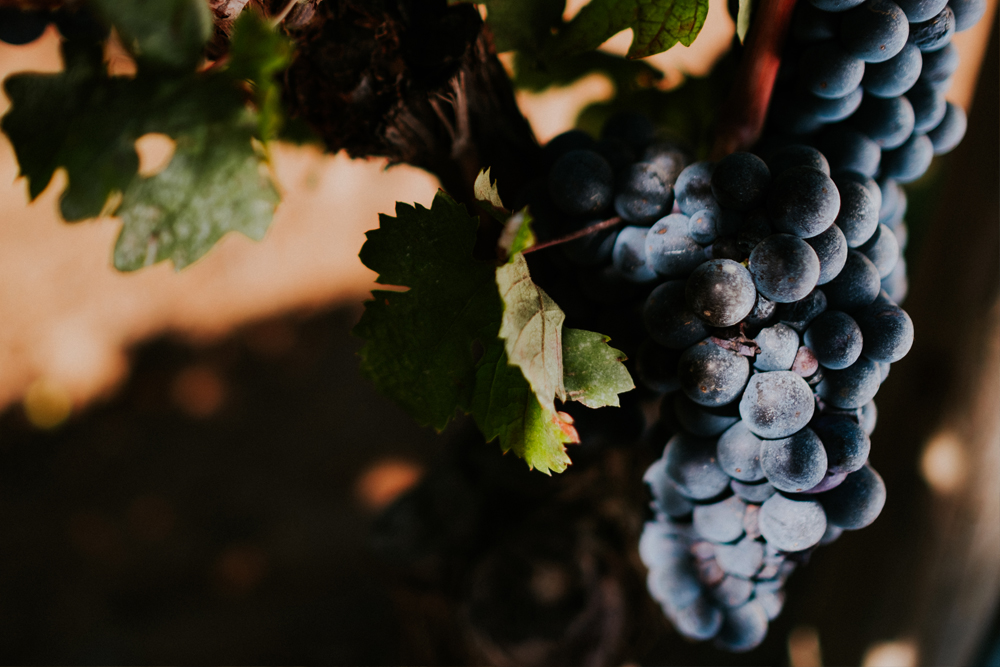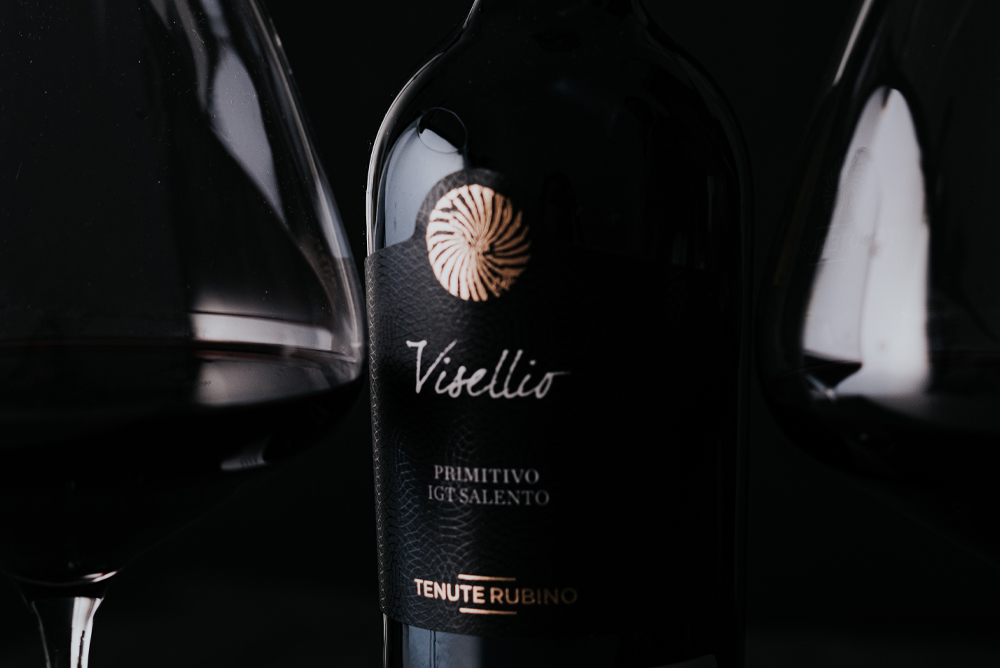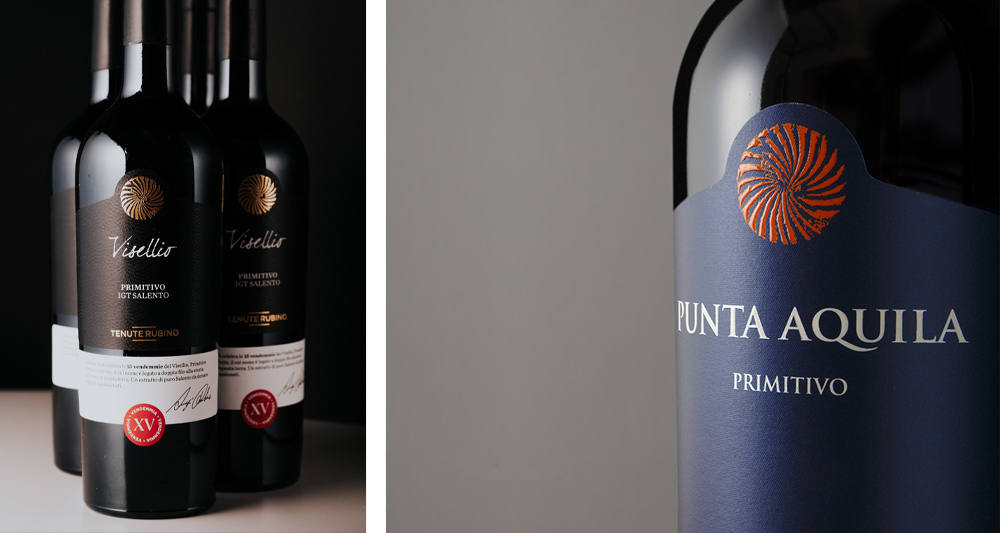-
Jaddico Estate
-
Uggìo-Punta Aquila Estate
-
The Ostuni vineyard
-
Palombara Estate
-
Padula di Geremia Estate
-
Torre Testa
-
Visellio
-
V’itra
-
Jaddico
-
Palombara
-
Oltremé
-
Miraglio
-
Punta Aquila
-
Lamo
-
Sumaré 27 months
-
Sumaré 60 months
-
Salende
-
Libens
-
Lamiro
-
Giancòla
-
Saturnino
-
Oltremé Rosato
-
Torre Testa Rosato
-
Aleatico
-
Aspettando San Martino
-
Cantine Aperte
-
La Vendemmia delle donne
-
RAP
-
Rubino Wine Party
-
Saturnino Wine Party
-
Tenute Rubino Wine & Friends
Primitivo
Primitivo, Apulia’s wine ambassador to the world, telling the story of places, traditions, cultures and lands.
Name and History
Primitivo is a black native grape variety from Apulia. The name originates from the precociousness of its vegetative phases, with the harvest period running from the end of August to the first ten days of September.
The historical evolution of this variety has distant and uncertain origins, its genealogy most likely beginning in Illyria, an ancient land corresponding to the western part of the Balkan peninsula. Between the fifteenth and sixteenth century it was probably brought over to Apulia by Slavic refugees called Zagarese (from Zagabria) and then spread and planted across the territories of Bari and in Salento. At the end of the 18th and beginning of the 19th century, it was the prior Don Francesco Filippo Indellicati who selected a particular clone of this vine, in the area of Gioia del Colle, officially determining the birth and consecration of Primitivo.

Varietal characteristics
Primitivo in Apulia, particularly in the Salento area, has found its perfect micro environment to grow and produce healthy grapes with huge potential for high quality winemaking.
In Apulia the vines are typically planted using the alberello training system, an ancient method of vine training dating back to the period of the ancient Greeks. The yield from a Primitivo vine using the alberello method is modest, while at the same time guaranteeing quality grapes for high quality wines.
The vines are often ungrafted and American rootstock isn’t necessary to avoid the phylloxera insect, as the naturally sandy terrains typical in Salento are already a natural defence against this insect.
Primitivo berries are characterized by their spherical shape and medium size, with a very pruinose skin.
It is worth noting that among the main characteristics of the Primitivo grape is its high level of sugar, making it a potentially high alcohol wine, and also the significant anthocyanin content in its intense blue skins, giving the Primitivo wines an intense colour.
Organoleptic characteristics
Organoleptically, Primitivo wines present characteristics that specifically affirm their identity.
The colour is typically an intense ruby red with violet hues, while on the nose Primitivo wines enjoy an intense and complex bouquet with fruity notes going from cherries to plums, from red currants to blackberries and with touches of floral notes, particularly violets.
During maturation the nose is enriched further with tertiary notes such as cinnamon, black pepper, tobacco, liquorice and cocoa.
On the palate it is velvety, structured and with an imposing tannin.
These wines have a lot of body and an elegance which matches the strength and the complexity of the variety.
Ampelographic Description
Bud burst:
At bud burst the bud has an expanded, wooly, green apex with a brushed rim, the apical and basal leaflets are folded and wooly, green in colour with a reddish edge in the apical area; the bud’s axis has a pastoral formation.
Shoots:
The shoots are characterised by an almost circular cross section, with a smooth angular profile, green in colour with shades of reddy-purple.
Tendrils:
The tendrils are long and thick, with a bifid and sometimes trifid form.
Inflorescence:
The inflorescence is around 10-18 cm long and has a simple winged or double form.
Flower:
The flower is a hermaphrodite and therefore self fertilising, it has a cylindrical flower bud and is rather large.
Leaf:
The leaf is medium-sized with a five-lobed pentagonal shape. The petiolar sinus is a closed lyre shape with overlapping edges, while the lateral ones are open in a tight U shape, with parallel or converging edges.
The upper leaf is a deep, opaque green and smooth, while the lower leaf is light green, wooly with pronounced primary and secondary veins, velvety, green and partially red at the intersection with thick, wavy and wrinkly edges.
The stalk is green with hints of red, it is medium length and thickness and smooth, with an obvious canal in the cross section.
Bunch:
The Primitivo bunch is fairly compact, with a conical-cylindrical simple, winged or double shape.
It is around 14-17 cm long, the peduncle is visible, short, thick and semi-woody.
The pedicels are medium, green, and with visible ends. The brush is medium size and yellowy- red in colour with purple highlights; the pedicel is easily removed from the grape.
Grape:
The grape is medium size (13-17mm) and is spherical with a circular cross section.
The skin is medium thickness, with bloom and an even blue colour.
The pulp is sweet and juicy with a characteristic aromatic flavour and wine coloured juice.
The pedicel is easily removed from the grape.
Seeds:
The seeds are on average 1-2 per grape, and exceptionally even 3. They are medium size, long, pyriform and a reddish colour.
Cane:
The cane is medium length, robust, with few branches and an unresistant bark with a circular cross section. A stretched surface with bloom, a sandy-grey purple with highlights of red wine colour, uniformly coloured and more intense towards the knots.
The internodes are around 8-10 cm long, with lots of lateral shoots.
Rounded, smooth, protruding buds.
The petiole is tight and not evident, the diaphragm is convex.
Trunk:
The trunk of the vine is fairly vigorous and robust with an upright structure.
Phenology
Vegetative Phenomenon
Bud burst occurs between the last week in March and the first 10 days of April, to allow time for flowering between the 10th May and the 25th May. Veraìson occurs in the first ten days of July, allowing for the maturation of the grapes by the end of August and the the beginning of September for the first product and between the 20th and 30th September for the second product. This demonstrates why Primitivo is famous for its precocious harvest. The leaves fall during the month of November.
Cultivation aptitudes and characteristics
Vigour:
A mediocre vigour.
Production:
The production is discontinuous but abundant and of good quality.
The first production (at the end of August in the hottest areas) happens with the basal buds and is made up of bunches of the aforementioned; the second production from the pistils, which are extremely fertile, happens in the second half of September, and the third in the first ten days of October.
The first harvest is around 30 q/ha ; the second around 10-20. The first product has higher levels of sugar and lower levels of acidity compared to the second. It is very susceptible to floral abortion when the vines grow in deep and quite damp soils, especially when the autumn and winter seasons are particularly wet or, worse still, if the spring is quite wet with large diurnal ranges.
Positioning of the first bud: 2nd and 3rd knot.
Average number of inflorescences per bud: 2
Lateral shoots fertility: excellent
Multiple grafting development: normal. Compatible with all American rootstocks: does well with almost all of them, with the exception of “Berlandieri X Riparia 225” which encourages coulure
The wines
The wines obtained from Tenute Rubino’s Primitivo grapes follow three different expressions of the same variety, creating different wines, each of which represents a different estate and terroir: Punta Aquila and Palombara from their respective estates, and Visellio from the Uggìo estate.

